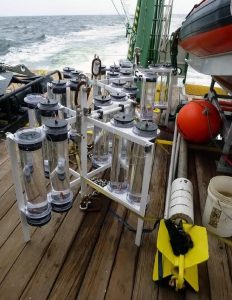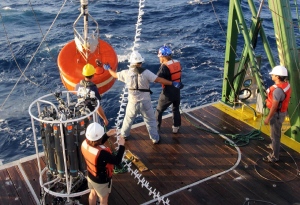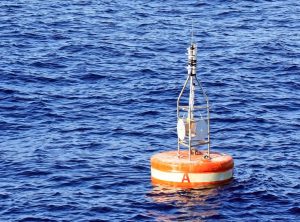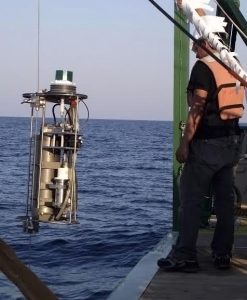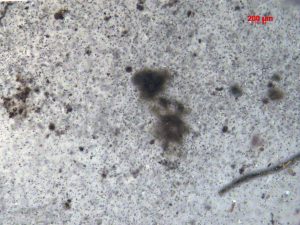Study Demonstrates Sinking Marine Particles Help Remove PAHs from Water Column
– FEBRUARY 16, 2017
Researchers measured polycyclic aromatic hydrocarbon (PAH) concentrations in water collected near the Deepwater Horizon site to understand how sinking particles, such as marine snow, influence the residence time of PAHs in the upper ocean. They observed that dissolved PAH concentrations had decreased by over 1,000 times compared with concentrations reported during and immediately after the oil spill. They found that sinking particulate matter can remove up to 7% of particle-bound PAHs daily in the Gulf of Mexico. The researchers published their findings in Marine Chemistry: Vertical fluxes of polycyclic aromatic hydrocarbons in the northern Gulf of Mexico.
Crude oils are composed of thousands of chemical compounds, and PAHs are a class of these compounds that cause health concerns in an oil spill. PAHs enter the Gulf of Mexico marine environment year round via oil seeps and spills, land runoff, river discharges, coastal erosion, and atmospheric deposition. These hydrophobic compounds, which do not dissolve quickly in water, attach to marine particles and are deposited to sediments. While studies have investigated the fate and transport of Deepwater Horizon oil in the northern Gulf of Mexico, this study is the first to address the residence times of PAHs in the water column.
Researchers collected water samples (for dissolved PAHs), suspended particles (for particulate PAHs) and settling particles (for sinking PAHs). The team used sediment traps to collect sinking particles and pumps to filter water for suspended particles. They characterized PAH distribution, the removal mechanisms, and residence times.
Vertical profile samples exhibited a general pattern of low PAH concentrations at 100 m depth, elevated concentrations at 150 m depth, and then decreased or constant concentrations at further depths. Vertical profiles showed maximum particulate PAH concentrations at 100 m that remained similar throughout the water column to 350 m depth. Lower and middle molecular weight PAHs – which attach to marine particles more easily – dominated sinking PAH concentrations, confirming marine particles’ role in vertical PAH fluxes. The team determined that if vertical sinking was regarded as the only removal pathway, PAHs’ would exhibit residence times of about 15 days in the upper euphotic zone.
“Our results showed that the sinking particles including marine snow can efficiently transport PAHs from the surface oceans to the seafloor, and it is a key factor controlling PAHs’ removal from the upper oceans,” said study author Puspa Adhikari. This study is the first to measure particulate PAH concentrations and sinking PAH fluxes simultaneously using large-volume in situ pumps and drifting sediment traps, which allowed researchers to directly estimate particulate PAH loss due to vertical fluxes and better understand vertical sinking’s role in open-ocean PAH cycling.
Data are publicly available through the Gulf of Mexico Research Initiative Information & Data Cooperative (GRIIDC) at doi: 10.7266/N7N29TXF.
The study’s authors are Puspa L. Adhikari, Kanchan Maiti, and Edward B. Overton.
************
This research was made possible in part by a grant from the Gulf of Mexico Research Initiative (GoMRI) to Louisiana State University for their project Investigating the Potential Ecological Impacts of the Deepwater Horizon Oil Spill and the Biologically-mediated Mechanisms of Removal of Polycyclic Aromatic Hydrocarbons (PAHs).
The Gulf of Mexico Research Initiative (GoMRI) is a 10-year independent research program established to study the effect, and the potential associated impact, of hydrocarbon releases on the environment and public health, as well as to develop improved spill mitigation, oil detection, characterization and remediation technologies. An independent and academic 20-member Research Board makes the funding and research direction decisions to ensure the intellectual quality, effectiveness and academic independence of the GoMRI research. All research data, findings and publications will be made publicly available. The program was established through a $500 million financial commitment from BP. For more information, visit https://gulfresearchinitiative.org/.
© Copyright 2010-2017 Gulf of Mexico Research Initiative (GoMRI) – All Rights Reserved. Redistribution is encouraged with acknowledgement to the Gulf of Mexico Research Initiative (GoMRI). Please credit images and/or videos as done in each article. Questions? Contact web-content editor Nilde “Maggie” Dannreuther, Northern Gulf Institute, Mississippi State University (maggied@ngi.msstate.edu).

